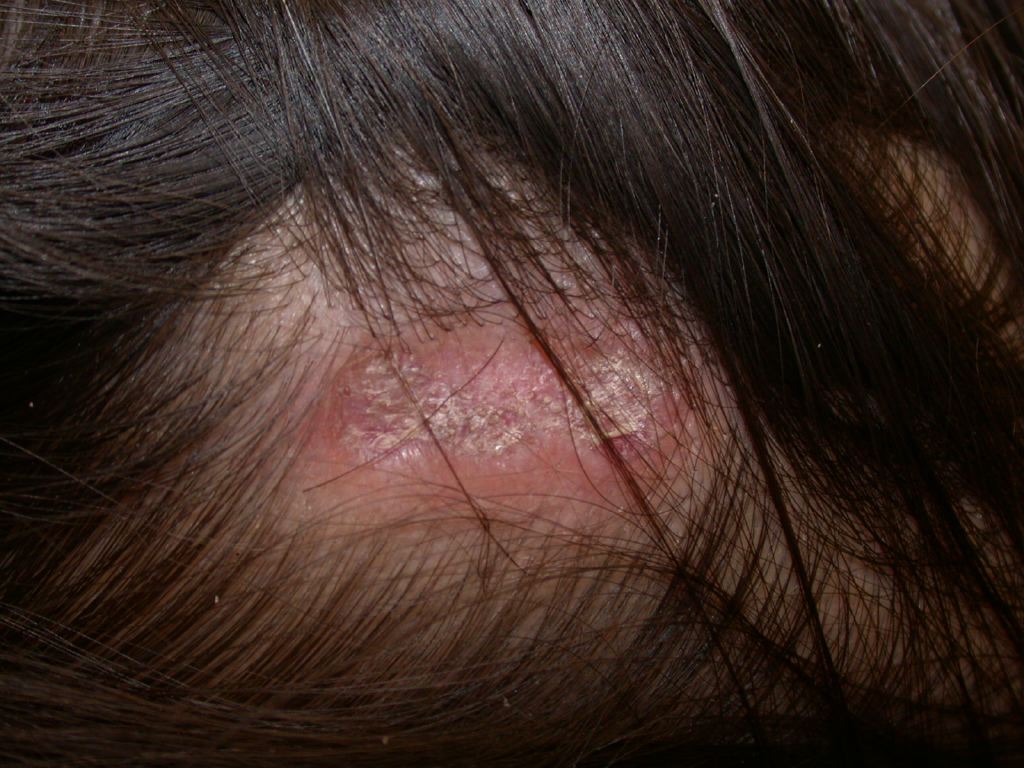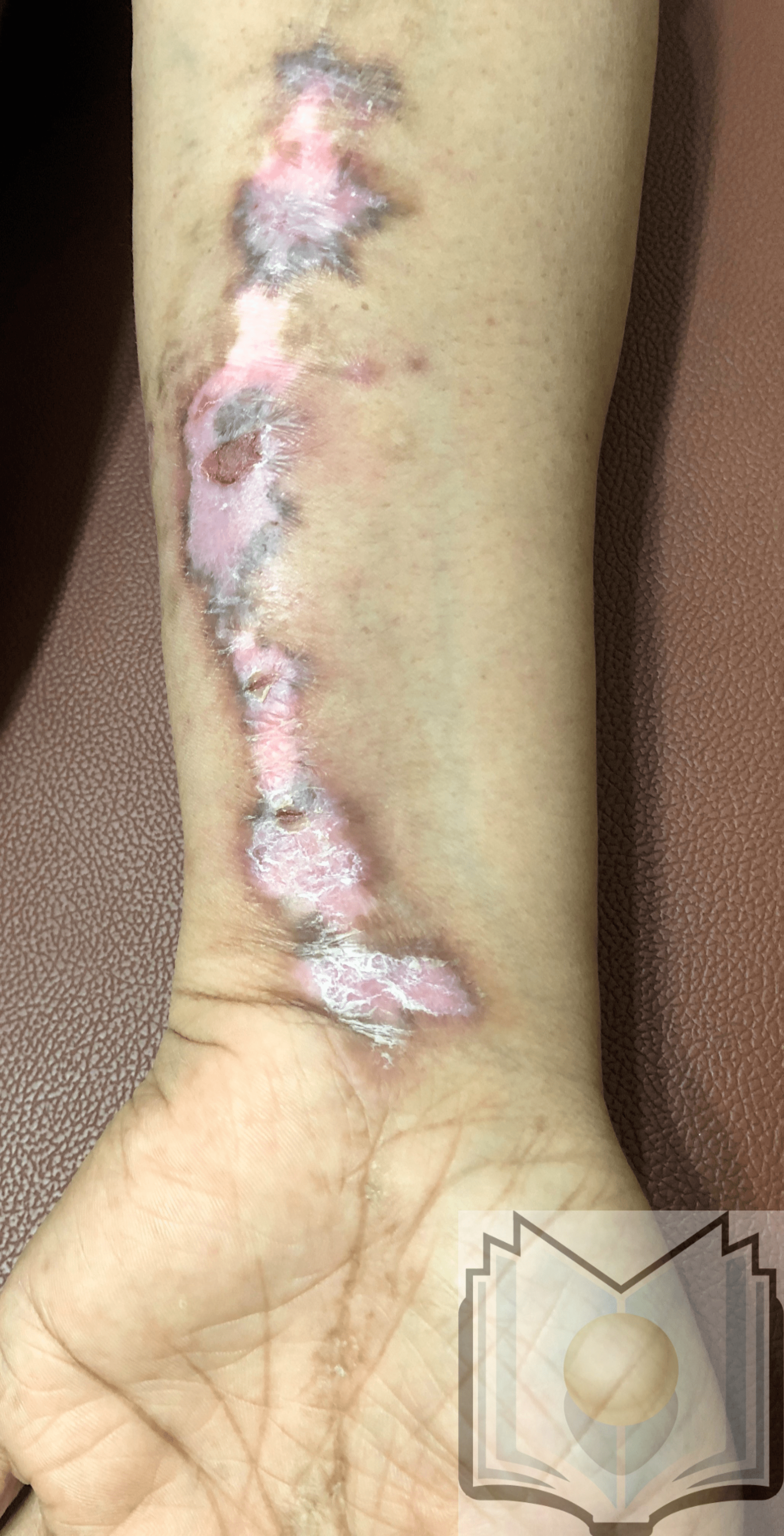[1]
Udompanich S, Chanprapaph K, Suchonwanit P. Hair and Scalp Changes in Cutaneous and Systemic Lupus Erythematosus. American journal of clinical dermatology. 2018 Oct:19(5):679-694. doi: 10.1007/s40257-018-0363-8. Epub
[PubMed PMID: 29948959]
[2]
Dammacco R, Procaccio P, Racanelli V, Vacca A, Dammacco F. Ocular Involvement in Systemic Lupus Erythematosus: The Experience of Two Tertiary Referral Centers. Ocular immunology and inflammation. 2018:26(8):1154-1165. doi: 10.1080/09273948.2018.1501495. Epub 2018 Aug 10
[PubMed PMID: 30096011]
[3]
Abadías-Granado I, Sánchez-Bernal J, Felipo-Berlanga F, Ara-Martín M. Coexistence of Tumid Lupus Erythematosus and Discoid Lupus Erythematosus. Actas dermo-sifiliograficas. 2019 Apr:110(3):253-255. doi: 10.1016/j.ad.2018.02.023. Epub 2018 Jul 30
[PubMed PMID: 30072022]
[4]
Sontheimer RD. The lexicon of cutaneous lupus erythematosus--a review and personal perspective on the nomenclature and classification of the cutaneous manifestations of lupus erythematosus. Lupus. 1997:6(2):84-95
[PubMed PMID: 9061656]
Level 3 (low-level) evidence
[5]
Salah E. Clinical and dermoscopic spectrum of discoid lupus erythematosus: novel observations from lips and oral mucosa. International journal of dermatology. 2018 Jul:57(7):830-836. doi: 10.1111/ijd.14015. Epub 2018 Apr 27
[PubMed PMID: 29700807]
[6]
Drenkard C, Parker S, Aspey LD, Gordon C, Helmick CG, Bao G, Lim SS. Racial Disparities in the Incidence of Primary Chronic Cutaneous Lupus Erythematosus in the Southeastern US: The Georgia Lupus Registry. Arthritis care & research. 2019 Jan:71(1):95-103. doi: 10.1002/acr.23578. Epub
[PubMed PMID: 29669194]
[7]
Gaüzère L, Gerber A, Renou F, Ferrandiz D, Bagny K, Osdoit S, Yvin JL, Raffray L. [Epidemiology of systemic lupus erythematosus in Reunion Island, Indian Ocean: A case-series in adult patients from a University Hospital]. La Revue de medecine interne. 2019 Apr:40(4):214-219. doi: 10.1016/j.revmed.2018.07.004. Epub 2018 Jul 21
[PubMed PMID: 30041816]
Level 3 (low-level) evidence
[8]
Oh EH, Kim EJ, Ro YS, Ko JY. Ten-year retrospective clinicohistological study of cutaneous lupus erythematosus in Korea. The Journal of dermatology. 2018 Apr:45(4):436-443. doi: 10.1111/1346-8138.14233. Epub 2018 Feb 9
[PubMed PMID: 29423919]
Level 2 (mid-level) evidence
[9]
Kahn JS, Deverapalli SC, Rosmarin DM. JAK-STAT signaling pathway inhibition: a role for treatment of discoid lupus erythematosus and dermatomyositis. International journal of dermatology. 2018 Aug:57(8):1007-1014. doi: 10.1111/ijd.14064. Epub 2018 Jun 5
[PubMed PMID: 29873082]
[10]
Two A, So JK, Paravar T. Discoid Lupus and Human Immunodeficiency Virus: A Retrospective Chart Review to Determine the Prevalence and Progression of Co-occurrence of these Conditions at a Single Academic Center. Indian journal of dermatology. 2017 Mar-Apr:62(2):226. doi: 10.4103/0019-5154.201750. Epub
[PubMed PMID: 28400654]
Level 2 (mid-level) evidence
[12]
Mutasim DF, Adams BB. Immunofluorescence in dermatology. Journal of the American Academy of Dermatology. 2001 Dec:45(6):803-22; quiz 822-4
[PubMed PMID: 11712024]
[13]
Dahl MV. Usefulness of direct immunofluorescence in patients with lupus erythematosus. Archives of dermatology. 1983 Dec:119(12):1010-7
[PubMed PMID: 6360051]
[14]
Harrist TJ, Mihm MC Jr. The specificity and clinical usefulness of the lupus band test. Arthritis and rheumatism. 1980 Apr:23(4):479-90
[PubMed PMID: 6989372]
[15]
George R, Kurian S, Jacob M, Thomas K. Diagnostic evaluation of the lupus band test in discoid and systemic lupus erythematosus. International journal of dermatology. 1995 Mar:34(3):170-3
[PubMed PMID: 7751090]
[16]
Chong BF, Song J, Olsen NJ. Determining risk factors for developing systemic lupus erythematosus in patients with discoid lupus erythematosus. The British journal of dermatology. 2012 Jan:166(1):29-35. doi: 10.1111/j.1365-2133.2011.10610.x. Epub 2011 Dec 5
[PubMed PMID: 21910708]
[17]
Inamadar AC. Perforation of paper with pen: Simple technique to explain the carpet tack sign in discoid lupus erythematosus. Journal of the American Academy of Dermatology. 2019 Dec:81(6):e159-e160. doi: 10.1016/j.jaad.2019.03.039. Epub 2019 Mar 22
[PubMed PMID: 30905795]
[18]
Rowell NR. Laboratory abnormalities in the diagnosis and management of lupus erythematosus. The British journal of dermatology. 1971 Mar:84(3):210-6
[PubMed PMID: 4102091]
[19]
Zaalberg A, Moradi Tuchayi S, Ameri AH, Ngo KH, Cunningham TJ, Eliane JP, Livneh M, Horn TD, Rosman IS, Musiek A, Anadkat MJ, Demehri S. Chronic Inflammation Promotes Skin Carcinogenesis in Cancer-Prone Discoid Lupus Erythematosus. The Journal of investigative dermatology. 2019 Jan:139(1):62-70. doi: 10.1016/j.jid.2018.06.185. Epub 2018 Jul 17
[PubMed PMID: 30030152]
[20]
Farley-Loftus R, Elmariah SB, Ralston J, Kamino H, Franks AG Jr. Hypertrophic discoid lupus erythematosus. Dermatology online journal. 2010 Nov 15:16(11):1
[PubMed PMID: 21163152]
[21]
Flynn A, Gilhooley E, O'Shea F, Wynne B. The use of SLICC and ACR criteria to correctly label patients with cutaneous lupus and systemic lupus erythematosus. Clinical rheumatology. 2018 Mar:37(3):817-818. doi: 10.1007/s10067-018-3999-0. Epub 2018 Feb 1
[PubMed PMID: 29392510]
[22]
Xie HH, Shen H, Zhang L, Cui MY, Xia LP, Lu J. Elevated Serum Interleukin-34 Level in Patients with Systemic Lupus Erythematosus Is Associated with Disease Activity. Scientific reports. 2018 Feb 22:8(1):3462. doi: 10.1038/s41598-018-21859-z. Epub 2018 Feb 22
[PubMed PMID: 29472590]
[23]
Kretz CC, Norpo M, Abeler-Dörner L, Linke B, Haust M, Edler L, Krammer PH, Kuhn A. Anti-annexin 1 antibodies: a new diagnostic marker in the serum of patients with discoid lupus erythematosus. Experimental dermatology. 2010 Oct:19(10):919-21. doi: 10.1111/j.1600-0625.2010.01145.x. Epub
[PubMed PMID: 20701627]
[24]
Callen JP. Discoid lupus erythematosus--variants and clinical associations. Clinics in dermatology. 1985 Jul-Sep:3(3):49-57
[PubMed PMID: 3880023]
[25]
Muangchan C, van Vollenhoven RF, Bernatsky SR, Smith CD, Hudson M, Inanç M, Rothfield NF, Nash PT, Furie RA, Senécal JL, Chandran V, Burgos-Vargas R, Ramsey-Goldman R, Pope JE. Treatment Algorithms in Systemic Lupus Erythematosus. Arthritis care & research. 2015 Sep:67(9):1237-1245. doi: 10.1002/acr.22589. Epub
[PubMed PMID: 25777803]
[26]
Powers DB. Systemic lupus erythematosus and discoid lupus erythematosus. Oral and maxillofacial surgery clinics of North America. 2008 Nov:20(4):651-62. doi: 10.1016/j.coms.2008.07.001. Epub
[PubMed PMID: 18940631]
[27]
Francès C, Barète S, Piette JC. [Dermatologic manifestations in lupus erythematosus]. La Revue de medecine interne. 2008 Sep:29(9):701-9. doi: 10.1016/j.revmed.2008.04.021. Epub 2008 Jun 17
[PubMed PMID: 18562046]
[28]
Bjornberg A, Hellgren L. Topical treatment of chronic discoid lupus erythematosus with betamethason-17-valerate and fluocinolone acetonie-a double blind study. Indian journal of dermatology. 1966 Oct:12(1):17-8
[PubMed PMID: 5341750]
Level 1 (high-level) evidence
[29]
Jessop S, Whitelaw DA, Delamere FM. Drugs for discoid lupus erythematosus. The Cochrane database of systematic reviews. 2009 Oct 7:(4):CD002954. doi: 10.1002/14651858.CD002954.pub2. Epub 2009 Oct 7
[PubMed PMID: 19821298]
Level 1 (high-level) evidence
[30]
Tzellos TG, Kouvelas D. Topical tacrolimus and pimecrolimus in the treatment of cutaneous lupus erythematosus: an evidence-based evaluation. European journal of clinical pharmacology. 2008 Apr:64(4):337-41
[PubMed PMID: 18157526]
[31]
Sárdy M, Ruzicka T, Kuhn A. Topical calcineurin inhibitors in cutaneous lupus erythematosus. Archives of dermatological research. 2009 Jan:301(1):93-8. doi: 10.1007/s00403-008-0894-6. Epub 2008 Sep 17
[PubMed PMID: 18797893]
[32]
Marmor MF, Kellner U, Lai TY, Melles RB, Mieler WF, American Academy of Ophthalmology. Recommendations on Screening for Chloroquine and Hydroxychloroquine Retinopathy (2016 Revision). Ophthalmology. 2016 Jun:123(6):1386-94. doi: 10.1016/j.ophtha.2016.01.058. Epub 2016 Mar 16
[PubMed PMID: 26992838]
[33]
Cavazzana I, Sala R, Bazzani C, Ceribelli A, Zane C, Cattaneo R, Tincani A, Calzavara-Pinton PG, Franceschini F. Treatment of lupus skin involvement with quinacrine and hydroxychloroquine. Lupus. 2009 Jul:18(8):735-9. doi: 10.1177/0961203308101714. Epub
[PubMed PMID: 19502270]
[34]
Seiger E, Roland S, Goldman S. Cutaneous lupus treated with topical tretinoin: a case report. Cutis. 1991 May:47(5):351-5
[PubMed PMID: 2070657]
Level 3 (low-level) evidence
[35]
Kuhn A, Ruland V, Bonsmann G. Cutaneous lupus erythematosus: update of therapeutic options part II. Journal of the American Academy of Dermatology. 2011 Dec:65(6):e195-213. doi: 10.1016/j.jaad.2010.06.017. Epub 2010 Aug 30
[PubMed PMID: 20800319]
[36]
Wenzel J, Brähler S, Bauer R, Bieber T, Tüting T. Efficacy and safety of methotrexate in recalcitrant cutaneous lupus erythematosus: results of a retrospective study in 43 patients. The British journal of dermatology. 2005 Jul:153(1):157-62
[PubMed PMID: 16029342]
Level 2 (mid-level) evidence
[37]
Ortiz Z, Shea B, Suarez-Almazor ME, Moher D, Wells GA, Tugwell P. The efficacy of folic acid and folinic acid in reducing methotrexate gastrointestinal toxicity in rheumatoid arthritis. A metaanalysis of randomized controlled trials. The Journal of rheumatology. 1998 Jan:25(1):36-43
[PubMed PMID: 9458200]
Level 1 (high-level) evidence
[38]
Pelle MT, Werth VP. Thalidomide in cutaneous lupus erythematosus. American journal of clinical dermatology. 2003:4(6):379-87
[PubMed PMID: 12762830]
[39]
Chasset F, Tounsi T, Cesbron E, Barbaud A, Francès C, Arnaud L. Efficacy and tolerance profile of thalidomide in cutaneous lupus erythematosus: A systematic review and meta-analysis. Journal of the American Academy of Dermatology. 2018 Feb:78(2):342-350.e4. doi: 10.1016/j.jaad.2017.09.059. Epub 2017 Oct 5
[PubMed PMID: 28989111]
Level 1 (high-level) evidence
[40]
Généreau T, Chosidow O, Danel C, Chérin P, Herson S. High-dose intravenous immunoglobulin in cutaneous lupus erythematosus. Archives of dermatology. 1999 Sep:135(9):1124-5
[PubMed PMID: 10490126]
[41]
Chen P, Broadbent E, Coomarasamy C, Jarrett P. Illness perception in association with psychological functioning in patients with discoid lupus erythematosus. The British journal of dermatology. 2015 Sep:173(3):824-6. doi: 10.1111/bjd.13709. Epub 2015 Jul 20
[PubMed PMID: 25639859]
[42]
Kuhn A,Sonntag M,Richter-Hintz D,Oslislo C,Megahed M,Ruzicka T,Lehmann P, Phototesting in lupus erythematosus: a 15-year experience. Journal of the American Academy of Dermatology. 2001 Jul;
[PubMed PMID: 11423840]
[43]
Wozniacka A, Carter A, McCauliffe DP. Antimalarials in cutaneous lupus erythematosus: mechanisms of therapeutic benefit. Lupus. 2002:11(2):71-81
[PubMed PMID: 11958581]
[44]
Cusack C, Danby C, Fallon JC, Ho WL, Murray B, Brady J, O'Kelly P, Ambrose N, Kearns G, Murphy GM. Photoprotective behaviour and sunscreen use: impact on vitamin D levels in cutaneous lupus erythematosus. Photodermatology, photoimmunology & photomedicine. 2008 Oct:24(5):260-7. doi: 10.1111/j.1600-0781.2008.00373.x. Epub
[PubMed PMID: 18811868]
[45]
Kuhn A, Landmann A, Wenzel J. Advances in the treatment of cutaneous lupus erythematosus. Lupus. 2016 Jul:25(8):830-7. doi: 10.1177/0961203316641771. Epub
[PubMed PMID: 27252259]
Level 3 (low-level) evidence
[46]
Meller S, Homey B, Ruzicka T. Socioeconomic factors in lupus erythematosus. Autoimmunity reviews. 2005 Apr:4(4):242-6
[PubMed PMID: 15893719]
[47]
Jessop S, Whitelaw DA, Grainge MJ, Jayasekera P. Drugs for discoid lupus erythematosus. The Cochrane database of systematic reviews. 2017 May 5:5(5):CD002954. doi: 10.1002/14651858.CD002954.pub3. Epub 2017 May 5
[PubMed PMID: 28476075]
Level 1 (high-level) evidence
[48]
Drucker AM, Su J, Mussani F, Siddha SK, Gladman DD, Urowitz MB. Prognostic implications of active discoid lupus erythematosus and malar rash at the time of diagnosis of systemic lupus erythematosus: Results from a prospective cohort study. Lupus. 2016 Apr:25(4):376-81. doi: 10.1177/0961203315610645. Epub 2015 Oct 8
[PubMed PMID: 26453664]


